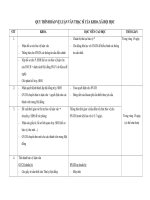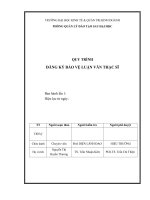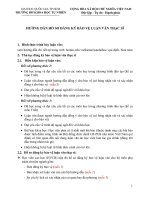POWERPOINT BAO VE LUAN VAN THAC SI
Bạn đang xem bản rút gọn của tài liệu. Xem và tải ngay bản đầy đủ của tài liệu tại đây (903.23 KB, 27 trang )
THU DAU MOT UNIVERSITY
FACULTY OF FOREIGN LANGUAGES
MASTER THESIS DEFENSE
AN INVESTIGATION INTO LANGUAGE LEARNING STRATEGIES TO IMPROVE ENGLISH
SPEAKING SKILLS AMONG HIGH SCHOOL STUDENTS: A CASE OF THREE HIGH
SCHOOLS IN BINH DUONG PROVINCE.
Cover
MAJOR: ENGLISH LANGUAGE
Presented by Hoang Thi Le Quyen
MAJOR CODE: 8 22 02 01
Supervised by Ph.D. Tran Thanh Du
Binh Duong, September 2023
01
Outline
01
Chapter 1: Introduction
02
Chapter 2: Literature Review
03
Chapter 3: Methodology
04
Chapter 4: Findings and
05
discussions
AN INVESTIGATION INTO LANGUAGE LEARNING STRATEGIES AMONG HIGH SCHOOL STUDENTS…
02
Chapter 1:
INTRODUCTION
Statement of the problem
● The importance and dominance of English
● The reformation of English educational programs
● Language learning strategies have emerged not only as integral components of
various theoretical models of language proficiency (Ellis, 1985; Bachman &
Palmer, 1996) but also as a means of achieving learners' autonomy in the
process of language learning.
● High-school students have not determined language learning strategies yet
although all of them want to study English well.
03
AN INVESTIGATION INTO LANGUAGE LEARNING STRATEGIES AMONG HIGH SCHOOL STUDENTS…
Chapter 1:
INTRODUCTION
Scope of the study
The research focused on students’ language learning strategies to improve their
speaking skills and factors affecting students’ use of language learning strategies.
Aims of the study
(1) students’ language- learning strategies to develop speaking skills, (2) the effects of
motivation on LLS choices, and (3) the differences among the 10th, 11th, and 12th
graders’ use of language- learning strategies to work out efficient and effective ones.
Significantly, the study aimed to help improve students’ speaking skills based on the
differences among three grades.
04
AN INVESTIGATION INTO LANGUAGE LEARNING STRATEGIES AMONG HIGH SCHOOL STUDENTS…
Chapter 2:
LITERATURE REVIEW
2.1.1.Overview of
speaking
2.1.1.1. Definitions of
speaking
2.1.1.2. The importance of
speaking skills
2.1.1.3. Communicative
competence
2.1.2. Language
learning strategies
2.1.2.1. Definitions of LLS
2.1.2.2. Classifications of
language learning strategies
2.1.3. The effects of
Emily
motivation
on LLS choice
2.1.3.1. Factors Affecting the
Choice of LLS
2.1.3.1. Motivation
2.2. Previous studies
2.2.1. Foreign studies
2.2.2. Local studies
05
AN INVESTIGATION INTO LANGUAGE LEARNING STRATEGIES AMONG HIGH SCHOOL STUDENTS…
Chapter 1:
INTRODUCTION
2.1.2. Language learning strategies
Rubin (1975), one of the earliest researchers in this field, defined learning strategies
as “the techniques or devices which a learner may use to acquire knowledge” (Rubin,
1975, p.43)
Oxford (1990) also defines language-learning strategies as approaches or techniques
that learners use to enhance their progress in developing L2 skills. More specifically,
the author also considers language learning strategies to be “steps taken by students
to enhance their learning” (Oxford 1990, p.8).
06
AN INVESTIGATION INTO LANGUAGE LEARNING STRATEGIES AMONG HIGH SCHOOL STUDENTS…
LANGGUAGE
LEARNING
STRATEGIES
Chapter 2:
LITERATURE REVIEW
Memory strategies
DIRECT
Cognitive strategies
Compensation strategies
Metacognitive strategies
INDIRECT
Figure 2.1. Diagram of the Strategy
System (Oxford, 1990, pp. 16-21)
Affective strategies
Social strategies
AN INVESTIGATION INTO LANGUAGE LEARNING STRATEGIES AMONG HIGH SCHOOL STUDENTS…
07
Speaking
skills
Florez
Vestibulum
congue
(1999),
Vestibulum
congue
Harmer
(2007)
and classifications of LLS
mentioned
above,
definition
the
and
classification of Oxford
Language
learning
Theoretical
strategies
basis
Rubin (1981),
O'Malley
et
Vestibulum
congue
Vestibulum congue
Motivation
al.
(Dornyei
(1985),
(2001)
Oxford
(1990)
(1990) were chosen by
the research author as a
guideline
for
this
research.
ue
Ve
sti
b
ng
co
ulu
m
l um
co
u
tib
ng
ue
s
Ve
Chapter 2:
LITERATURE REVIEW
Among the definitions
08
AN INVESTIGATION INTO LANGUAGE LEARNING STRATEGIES AMONG HIGH SCHOOL STUDENTS…
Chapter 3:
METHODOLOGY
RESEARCH QUESTIONS
The current study sought to answer the following questions.
01
What language learning strategies do students use to
enhance their speaking skills?
02
What should be done to improve the effectiveness of
language learning strategies for the students?
09
AN INVESTIGATION INTO LANGUAGE LEARNING STRATEGIES AMONG HIGH SCHOOL STUDENTS…
Chapter 3:
METHODOLOGY
01
02
03
Research methods
● Mixed methods
Participants
● Questionnaire: 370 students
● Interviews: 15 teachers and 18
students
● Experimental teaching: 3
classes/ school
Instrumentations
● Questionnaires: 12 close-ended
Qs
● Interviews: 5 Qs for T and 5 for
Ss
● Class observation: 9 classes
● Experimental teaching: 3
classes/school,
Page 10
AN INVESTIGATION INTO LANGUAGE LEARNING STRATEGIES AMONG HIGH SCHOOL STUDENTS…
Chapter 3:
METHODOLOGY
Table 1.1. The population of the three high schools
High Schools
Number of Classes
Total Students
Female Students
Binh Phu
39
1597
923
Vo Minh Duc
43
1697
945
Nguyen Thi Minh Khai
38
1659
936
Total:
4.953 students
n is the sample size, N is the population size, and e is the level of precision. Yamane (1967.
p.886)
AN INVESTIGATION INTO LANGUAGE LEARNING STRATEGIES AMONG HIGH SCHOOL STUDENTS…
11
Chapter 3:
METHODOLOGY
Validity and reliability
Categories
Cronbach’s Alpha
Number of items
1. Students’ motivation
.727
5
2. Students’ LLS
.760
12
.668
34
3. Classroom observation
checklist
Table 3.4. Cronbach’s Alpha for each category of the questionnaire
12
AN INVESTIGATION INTO LANGUAGE LEARNING STRATEGIES AMONG HIGH SCHOOL STUDENTS…
Chapter 3:
METHODOLOGY
Data collection and analysis
1
2
3
4
ask for
permission
Clear explanation
Questionnaires,
interviews
class
observation, test
results
The calculation tool named Statistical Package for the Social Sciences 20 (SPSS 20)
was applied to determine the reliability of the questionnaire and the class observation
checklist (Cronbach’s Alpha). SPSS was also used to analyze and compare the results
of pretest, midterm test, and posttest based on mean, mode, median, and Sig.
(Significance Level).
13
AN INVESTIGATION INTO LANGUAGE LEARNING STRATEGIES AMONG HIGH SCHOOL STUDENTS…
Chapter 4:
FINDINGS AND DISCUSSIONS
4.1.1. Findings from questionnaires about students’ English learning
Table 4.1. Students' English learning
Questions
Options
1
2
3
4
5
F
P
F
P
F
P
F
P
F
P
Q1: Years of learning English
18
4.9
118
31.9
162
43.8
36
9.7
36
9.7
Q2: Degrees of liking English
94
25.4
107
28.9
40
10.8
78
21.1
51
13.8
Q4: Frequency of being
113
30.5
96
25.9
107
28.9
33
8.9
21
5.7
129
34.9
119
32.2
56
15.1
35
9.5
31
8.4
instructed LLS
Q5: Students’ need for an LLS
training course
Chapter 4:
FINDINGS AND DISCUSSIONS
15
AN INVESTIGATION INTO LANGUAGE LEARNING STRATEGIES AMONG HIGH SCHOOL STUDENTS…
Chapter 4:
FINDINGS AND DISCUSSIONS
16
AN INVESTIGATION INTO LANGUAGE LEARNING STRATEGIES AMONG HIGH SCHOOL STUDENTS…
Chapter 4:
FINDINGS AND DISCUSSIONS
17
AN INVESTIGATION INTO LANGUAGE LEARNING STRATEGIES AMONG HIGH SCHOOL STUDENTS…
Chapter 4:
FINDINGS AND DISCUSSIONS
18
AN INVESTIGATION INTO LANGUAGE LEARNING STRATEGIES AMONG HIGH SCHOOL STUDENTS…
Chapter 4:
FINDINGS AND DISCUSSIONS
4.1.2. Findings from interviews
The interview findings indicated that many students, especially the tenth
graders (4 of 6), were not confident speaking English. Most students did not
have their LLS to improve their English speaking skills.
4.1.2. Findings from classroom observations
Through four months of observing practical classes, the authors noticed students’
behaviors and activities. All classes often applied pair-work and group work (social
strategies), practicing (cognitive strategies), and reviewing (memorization strategies).
Students also used dictionaries to check the meanings of unfamiliar words but not for
pronunciation or collocations. They constantly attempted to remember single words; did
not put them out in phrases or sentences. Some of these classes utilized music; and
games (affective strategies). However, no classes focused on students’ pronunciation,
and even after students’ presentations, teachers did not correct their pronunciation
errors.
19
AN INVESTIGATION INTO LANGUAGE LEARNING STRATEGIES AMONG HIGH SCHOOL STUDENTS…
Chapter 4:
FINDINGS AND DISCUSSIONS
4.1.2. Findings from test results
20
AN INVESTIGATION INTO LANGUAGE LEARNING STRATEGIES AMONG HIGH SCHOOL STUDENTS…









